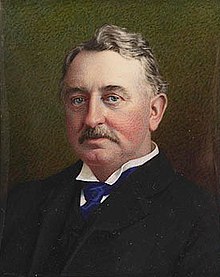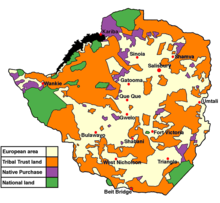Southern Rhodesia
Southern Rhodesia ( English Southern Rhodesia ) is the name of the former British colony in southern Africa , who in 1965 as the Republic of Rhodesia unilaterally declared (Republic of Rhodesia) under a white minority government for independent and in 1980 after elections with the participation of all political groups as Republic of Zimbabwe English ( : Zimbabwe ) received a black majority government. The crown colony, which continued to exist de jure, was finally given independence on April 18, 1980.
geography
The 390,757 km² former state (1.1 times the size of Germany) with 2,156,324 (1951) inhabitants was located between Northern Rhodesia (since 1964 Zambia ) and South Africa . This country shared a border with the Limpopo .
population
The population of Southern Rhodesia consisted of African ethnic groups, mainly Shona and Ndebele, as well as recent migrants .
- 1946 : 82,386 Europeans
- 1951 : 2,156,324 inhabitants: of which 2,010,000 blacks, 136,017 Europeans, 5,964 coloreds and 4,343 Asians
- 1964 : 4,207,000 inhabitants: 3,970,000 blacks, 217,000 Europeans, 20,000 coloreds and Asians.
history
Pre-European history
Around 1100 a Bantu people who knew about ore and metal extraction built the first stone houses in the city of Zimbabwe, which was founded around 800 . The rapidly growing city became the center of the Bantu empire Monomotapa , which reached far into what is now Mozambique and gained great power through gold mines .
Europeans came to the country only after David Livingstone (1855). In 1888, the king of the Ndebele granted Cecil Rhodes a land concession to exploit the ore deposits, whereupon many Europeans settled.
European colonial rule
In 1891, Great Britain declared the country a protectorate against German and Portuguese claims .
The first legislative assembly ( Legislative Council ) in Southern Rhodesia was established in 1898. A separate government of the colony with the status of self-government was not formed until 1923. During this period, British policy of safeguarding "domestic interests" created a right to amend and contradict the law. However, this legal right was never exercised. The government was led by the Rhodesia Party , chaired by the Prime Ministers, first Charles Patrick John Coghlan , then Howard Unwin Moffat and George Mitchell . In 1933, government power passed through elections to the Reform Party , which provided Prime Minister Godfrey Huggins (Lord Malvern). The following year this party split, but Huggins was able to maintain government power in new elections with his newly formed United Party (Rhodesia) (UP). He remained at the head of the local government until 1953. In the same year he was promoted to Federal Prime Minister who ruled the Federation of Rhodesia and Nyasaland . This also led to a change in the leadership of the United Party , which was renamed the United Federal Party (UFP) in 1957 and whose southern Rhodesian part formed the Rhodesian National Party (RNP) after 1963 . Edgar Whitehead took over the function of party chairman in 1953 . Prime Minister was Garfield Todd in 1953 and Edgar Whitehead in 1958.
In 1930 the colony was divided into settlement areas for whites and blacks, because southern Rhodesia was intended as a settlement colony . From 1953 to 1963 it formed the Central African Federation with its northern neighbor and Nyasaland (Malawi) , which was dissolved in 1963, among other things by the resistance of the Rhodesian African National Congress (ANC).
In contrast to the two neighboring countries, Great Britain denied independence to Southern Rhodesia in 1964 because the majority of the white population (less than 4%) under Ian Smith refused to allow the black majority to participate in government. The Smith administration pointed to the collapse of the former colonies, where the transfer of political power to representatives of the Bantu people had been seamless.
Since the declaration of independence in 1965
The unilaterally declared independence on November 11, 1965 by Prime Minister Ian Smith was punished internationally with an embargo and other sanctions (see also UN resolutions 216 and 217 ). At the same time, foreign-supported organizations began guerrilla warfare against the government and attacks against whites and blacks who worked with the government. About 250,000 whites held relative power over some 5 million blacks. The UN decided to boycott southern Rhodesia in order to persuade the government to give in. Negotiations between the government and the liberation movements failed in 1976. To end the guerrilla warfare , the Rhodesia Conference began in Geneva in 1976 . In 1978 the blacks received a majority in parliament and appointed the prime minister . However, the sanctions remained because the black guerrilla movements ZANU and ZAPU were not involved.
In 1979 Prime Minister Ian Smith agreed a ceasefire with the liberation movements . At the end of 1979 the conference achieved a breakthrough with the Lancaster House Agreement . In March 1980 elections took place with the participation of all political groups, which Robert Mugabe's ZANU party won.
On April 18, 1980, independent Zimbabwe was proclaimed. Mugabe took over from his predecessors a country that was known as the “ breadbasket of Africa” because of its high agricultural productivity and, among other things, because of a high literacy rate and well-developed infrastructure, compared to most neighboring countries, it had relatively good conditions for further successful development was no longer pursued with determination in the following years.
See also
Individual evidence
- ↑ a b c d Muriel Horrell: Days of Crisis in Rhodesia. Fact paper No. 16-1965 . SA Institute of Race Relations , Johannesburg 1965, p. 2
- ↑ Horrell: Days of Crisis , 1965, p. 30
- ^ Robert Cary, Diana Mitchell: African nationalist leaders in Rhodesia who's who . Africana book Society, Johannesburg, 1977 ISBN 0869201522 pp. 306-307
- ↑ Horrell: Days of Crisis , 1965, pp. 24, 50
- ↑ Ian Smith : The Great Betrayal. London 1997.
Coordinates: 19 ° S , 30 ° E







